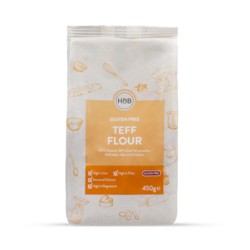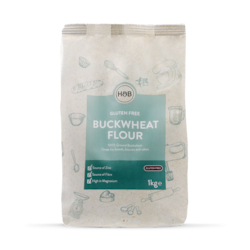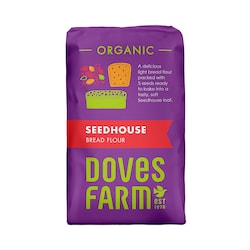15% off £30 OR 20% off £40
Substitutes for self-raising flour & other alternative flours

Want to switch up this diet staple so that you can pack in more nutrients?
From bagels to biscuits and pastries to pretzels, it’s hard to avoid white flour and, because it’s refined, many of its good-for-you qualities have been stripped away.
But wait! Not only are there many gluten-free flour alternatives, these alternatives are also loaded with vitamins and minerals, and are absorbed much more slowly and effectively, benefiting both your health AND your waistline.
What are the main types of flours?
Believe it or not, there are a fair few different flours out there, far more than most people realise. For instance, you’ve got: 1
Wheat flours
These flours tend to be used for bread-making due to the fact flour made from ‘hard’ wheat contains more protein, which makes bread dough sticky, elastic and able to hold air bubbles formed by a leavening agent as the dough rises.
Meanwhile, wholewheat flours tend to naturally contain B vitamins and iron, as well as selenium, potassium and magnesium. They’re also recognised as being good sources of fibre.
Within the wholewheat flour category there are several flours, including:
-
All purpose flour
Common characteristics: A refined blend of high-gluten hard wheat and low-gluten soft wheat. It’s milled with only endosperm, not bran or germ, and comes ready sifted. Some brands are fortified with calcium and Vitamins A or D.
Mainly used for: Baking, thickening and breading.
-
100% wholewheat flour
Common characteristics: This flour’s made from hulled red wheat grain, making it high in fibre and other nutrients. It’s often mixed with all-purpose flour for a lighter texture and better rising. It has a shorter shelf-life than all-purpose flour.
Mainly used for: Most things, such as bread-making and baking.
-
White wholewheat flour
Common characteristics: Is made from hulled white spring wheat.
Mainly used for: Baking for a milder taste and a lighter colour than baking that uses regular wholewheat flour.
-
Self-raising flour
Common characteristics: This is an all-purpose flour with added salt and baking soda. It has a fine texture and a high starch content and is made from soft wheat.
Mainly used for: Cakes and pastries.
-
Bread flour
Common characteristics: Is a refined flour made from hard wheat and a small amount of barley flour. It contains lots of gluten.
Mainly used for: Bread.
-
Gluten flour
Common characteristics: This is a refined flour made from hard wheat with minimum starch. It contains more protein than all-purpose flour for a higher rise and stronger dough.
Mainly used for: Bread.
-
Semolina flour
Common characteristics: Semolina flour is a coarsely-milled, refined hard durum wheat flour. It’s high in gluten.
Mainly used for: Pasta, couscous, gnocchi and puddings.
In addition to wholewheat flours, you also have….
Non-wheat flours
-
Almond meal/flour
Common characteristics: Made from blanched almonds, this flour is low in carbs and high in protein. It has a short shelf life and adds moisture and a nutty taste.
Mainly used for: Pastries, baking and desserts.
-
Amaranth flour
Common characteristics: It contains a high level of complete protein, including lysine, and tastes slightly nutty and sweet.
Mainly used for: Baking and thickening up sauces, gravies and soups.
-
Barley flour
Common characteristics: Is made from pearl or wholegrain barley and adds fibre to baking. It contains gluten, but doesn’t rise much.
Mainly used for: Baking and thickening up sauces, gravies and soups.
-
Buckwheat flour
Common characteristics: This flour is made from buckwheat and can be combined with other flours to add a hearty, grassy flavor and colour to bread.
Mainly used for: Pasta and pancakes.
-
Corn flour
Common characteristics: Is milled from the whole corn kernel and can be ground into corn flour in a blender.
Mainly used for: Bread and batter.
-
Flaxseed flour
Common characteristics: Made from whole flaxseeds, this flour contains Omega-3s and fibre. (Two tablespoons of flaxseed flour contains 4g of fibre).
Mainly used for: Baking and as a fat or egg substitute.
-
Oat flour
Common characteristics: Oat flour is ground from oat groats and has a rich, nutty flavor and dense texture.
Mainly used for: Baking.
Is self-raising flour bad?
Self-raising flour is like most other flours, it’s been refined, which means it tends to contain less protein and fibre than whole plant foods.
In turn, this means it’s less filing and relatively easy to overindulge on. 2
In a study published in the American Journal of Clinical Nutrition in 2010, researchers analysed the dietary habits, abdominal circumference and abdominal fat levels of 2,834 adults.
Those who ate wholegrains had significantly less abdominal fat than those who ate diets rich in refined grains. Maintaining normal levels of abdominal fat is important to maintain blood sugar control, cholesterol health and heart function.
Meanwhile, there is some nutritional value to self-raising flour. For example, 31g of self-raising flour contains:3
- 0g fat
- 4% calcium
- 14% iron
- 104% thiamine
- 60% riboflavin
- 8% niacin
Is plain flour bad?
It’s not necessarily the healthiest flour out there.
Quite a few different food products contain plain flour these days, which actually happens to turn into a glue-type substance by the time it’s reached our intestines. 4
Plain flour contains zero nutrients, and causes congestion within our system, which slows down digestion and creates a sluggish metabolism.
This often leads to weight gain, stress, headaches and migraines and constipation. Overall, plain flour is:
-
Acidic
When it’s refined, all the nutrients are removed, which actually makes plain flour acidic.
Diets that are high in acidic foods, such as fast food, force the body to pull calcium from bones, which in turn, affects bone density.
Over-acidity is one of the primary causes of chronic inflammation, which may cause arthritis and other chronic illnesses.
-
Can interfere with digestion
As we’ve just briefly mentioned, white flour is often referred to as being the ‘glue of the gut’ due to the gloopy consistency it takes on once inside the body.
-
Has no nutritional profile
Due to the fact plain flour’s refined, which involves removing the inner germ layer and outer bran. Any fibre and essential nutrients, such as vitamins and minerals and phytochemicals, tend to be lost during the refining process too.
Meanwhile, the bleaching process uses chemicals that contain artificial ingredients.
Summary
- There are so many different types of flour, which generally tend to fall into two main categories – wheat flour and non-wheat flour
- Self-raising flour has been refined so tends to contain less protein and fibre than whole plant foods
- Plain flour turns to a glue-like substance in our intestines that can interfere with digestion
Flour alternatives
Below are some substitutes for self-raising flour:5
-
Spelt flour
Eat to: Support immunity
Bronze Age Europeans were on to something when they began to cultivate spelt.
It’s thought to do wonders for our immunity as it’s high in thiamine, which helps to maintain muscle tone on the walls of the digestive tract, where much of our immune system is located.
It also contains iron – essential for digesting and absorbing nutrients from food. Like its close relative, wheat, spelt flour does contain gluten, but seems to be more easily tolerated.
-
Oat flour
Eat to: Feel fuller for longer
A wholegrain alternative to wheat flour, oat flour can be purchased or you can make your own by blending dried oats into a fine power.
Oat flour doesn’t rise in the same way wheat flour does, which means extra baking powder or another leavening agent is needed for a successful rise. Add 2.5 teaspoons of baking powder to every 92g of oat flour.
Note – Oat flour can contain gluten due to the oats being contaminated during the manufacturing process. Make sure you buy certified gluten-free oats.
-
Amaranth flour
Eat for: Amino acid goodness
Although technically not a grain, amaranth contains all nine essential amino acids and is an excellent source of fibre, vitamins and minerals.
It’s dense and hearty, making it ideal for whipping up a batch of pancakes and quick breads. For a fluffier texture, use a 50/50 mix of amaranth and a lighter flour.
You’ll also need to use a leavening agent too.
-
Wholewheat flour
Eat for: Overall good health
Wholewheat flour contains stacks of wholegrain goodness, including bran and wheatgerm.
Research has found people who regularly eat wholegrains are less likely to develop heart disease, certain cancers, diabetes and other infectious diseases.
If you’re planning on using wholewheat flour instead of self-raising, don’t forget your leavening agent.
-
All-purpose flour + a leavening agent
Use for: DIY self-raising flour
Using all-purpose or white flour is one of the most straightforward ways of replacing self-raising flour.
Basically, self-raising flour is just white flour combined with a leavening agent/baking powder.
If you like the sound of it, here are some recipe ideas, using different leavening agents:
- All-purpose/white flour with baking powder - for every three cups (375g) of flour, add two teaspoons (10g) of baking powder
- All-purpose/white flour with baking soda and cream of tartar - mix one-fourth teaspoon (1g) of baking soda and half a teaspoon (1.5g) of cream of tartar to one teaspoon (5g) of baking powder
- All-purpose/white flour with baking soda and buttermilk - mix one-fourth teaspoon (1g of baking soda and half a cup (123g) of buttermilk to equal one teaspoon (5g) of baking powder. You can use yogurt or sour milk instead of buttermilk
- All-purpose/white flour with baking soda and vinegar - mix one-fourth teaspoon (1g) of baking soda with half a teaspoon (2.5g) of vinegar to equal one teaspoon (5g) of baking powder. You can use lemon juice instead of vinegar
- All-purpose/white flour with baking soda + molasses - mix one-fourth teaspoon (1 gram) of baking soda with one-third cup (112 grams) of molasses to equal one teaspoon (5 grams) of baking powder. You can use honey instead of molasses.
Substitute for all-purpose flour
Run out of all-purpose flour and not sure what else to use instead? Or perhaps you just fancy a change from all-purpose flour? Here are some all-purpose flour alternatives: 6
-
Bread flour
Like all-purpose flour, bread flour is made from wheat, but a harder wheat berry, which means it contains more protein and gluten.
Often referred to as high-protein or high-gluten flour, its high gluten content makes breads and even cookies chewier.
You can substitute all or half of the flour in any baking recipe with bread flour, but don’t overmix if you are using it for cakes or pancake batter, unless you like really springy cakes and pancakes.
-
Cake flour
Made from a softer wheat, cake flour is specifically designed for baking tender and light cakes.
It’s really easy to make your own cake flour too, from all-purpose flour and cornstarch or arrowroot powder.
Measure one cup of all-purpose flour, minus 2 tablespoons of the flour, and add back 2 tablespoons of cornstarch or arrowroot powder for each cup of cake flour you need.
-
Wholewheat flour
Wholewheat flour’s made from the complete kernel of wheat, which includes the bran.
Due to the high fibre content, wholewheat flour can quickly absorb any moisture, which is why it’s always best to use a 50/50 mix of wholewheat and white flour when baking bread.
Quick breads and cookies are more forgiving, but using 7/8 cup of wholewheat flour in place of 1 cup of all-purpose flour will produce a better end product.
Flour alternatives for gluten-free
-
Quinoa flour
Eat to: Boost your nutrition levels
The ancient Incas called it ‘the mother of all grains’ and who are we to argue?
OK, so they were wrong about the grain bit, it’s actually a non-grassy plant that’s used like a cereal, but it sure packs a punch nutritionally.
Naturally gluten-free, it’s known as a complete protein, containing all nine essential amino acids, and is also high in fibre.
NASA declared quinoa the perfect food for a long voyage in space, so time to tuck in, Earthlings!
-
Rice flour
Eat to: Up your fibre intake
We all know when it comes to rice, brown is up there with the best.
Brown rice flour has the husk intact, providing insoluble fibre that helps waste material move through the intestine, so encourages regular bowel movements.
This naturally gluten-free flour could aid weight loss too, as a fibre-rich diet helps reduce hunger pangs and helps you feel fuller for longer.
-
Coconut flour
Eat to: Regulate your blood pressure
Naturally gluten-free, coconut flour is made from coconut flesh, which is then dried and finely ground.
Although it does contains saturated fat, it’s made of medium-chain triglycerides, shown to reduce abdominal obesity and increase metabolism.
Researchers found substituting regular flour with coconut when baking lowers the glycaemic index; the high fibre content means it doesn’t cause the spike in blood sugar that can occur with regular grains.
Look for coconut flour – without sweeteners or sulphites – to add flavour to cakes and bakes, and a velvety texture too.
-
Almond flour
Eat to: Help lower blood pressure
Ancient traders snacked on the sweet nuts from the wild almond trees growing on the Silk Road that connected central China with the Med, and the humble almond has been treasured since Biblical times.
The flour is made from blanched almonds (with skins removed) that are then finely ground and sifted.
Almonds are packed with magnesium, which can help lower blood pressure. Use almond flour instead of sugar and wheat for great low-carb, naturally gluten-free desserts and cakes.
-
Buckwheat flour
Eat to: Aid digestion
Don’t be confused by the name, this seed flour has nothing to do with wheat.
Traditionally only popular in Asia, we are finally waking up to the benefits of buckwheat in the West.
It’s full of nutrients and antioxidants, so much so it’s known as a ‘superfood’, and is said to clean and strengthen the intestines and improve appetite.
It is gluten-free, with a naturally sweet flavour that makes it a great base for pancakes, muffins and quick breads. So, buck up and get baking with buckwheat!
For more information on gluten-free flour, read this article: Gluten-free flour - the basics
Low carb flour alternatives
By now, you’ve probably realised just how many different types of flour there are and the many different flour alternatives, which also include low carb flours too.
We’ve already happened to mention some of these flour alternatives a bit further up, so won’t go into detail for all of these low carb options because we’ve already given you the lowdown on some of them!
Below are some low carb flour alternatives: 7
- Coconut flour.
- Almond flour.
- Ground flax meal - is also known as ground flax, ground flaxseeds or linseed. Flaxseeds are extremely nutritious and are an excellent source of vitamin B1, Copper and Omega 3. You can use flaxseeds to replace flour, as well as eggs.
- Sunflower seed or pumpkin seed meal - sunflower seed meal and pumpkin seed meal are ideal if you’re allergic to almond or coconut flour or any nut flour. They are high in vitamins and minerals, including Vitamin E, copper, thiamine, selenium and phosphorus.
- Psyllium husk – while it may not strictly be a flour, psyllium husk is an excellent low carb flour alternative. It’s packed full of fibre and can add volume to baking, as well as thicken recipes and act as a binding agent.
Summary
- Self-raising flour substitutes include: spelt, amaranth and oat flour
- Bread flour, cake flour and wholewheat flour are good all-purpose flour alternatives
- Flour alternatives for gluten-free diets include: quinoa, rice and coconut flour
Takeaway
The more you look, the more you find….which is precisely the case when it comes to flour.
Now that you’ve reached the end of this article, we’re sure you’re now fully aware of all of the many different alternative flours out there, which include substitutes for self-raising flour, substitutes for all-purpose flour and flour alternatives for gluten-free diets.
We also hope it’s inspired you to experiment with different flours, now that you know there are so many substitutes for flour out there; we hope you enjoy trying them!
Last updated: 23 July 2021
- https://foodandnutrition.org/summer-2012/flour-power-learn-different-kinds-flours/
- https://www.livestrong.com/article/501907-health-risk-of-eating-flour/
- https://www.eatthismuch.com/food/nutrition/self-rising-flour,506634/
- https://www.ndtv.com/health/is-white-flour-bad-for-your-health-1916518
- https://www.healthline.com/nutrition/self-rising-flour-substitutes#TOC_TITLE_HDR_3
- https://www.thekitchn.com/flour-substitute-23023177
- https://www.ditchthecarbs.com/low-carb-flours/



































